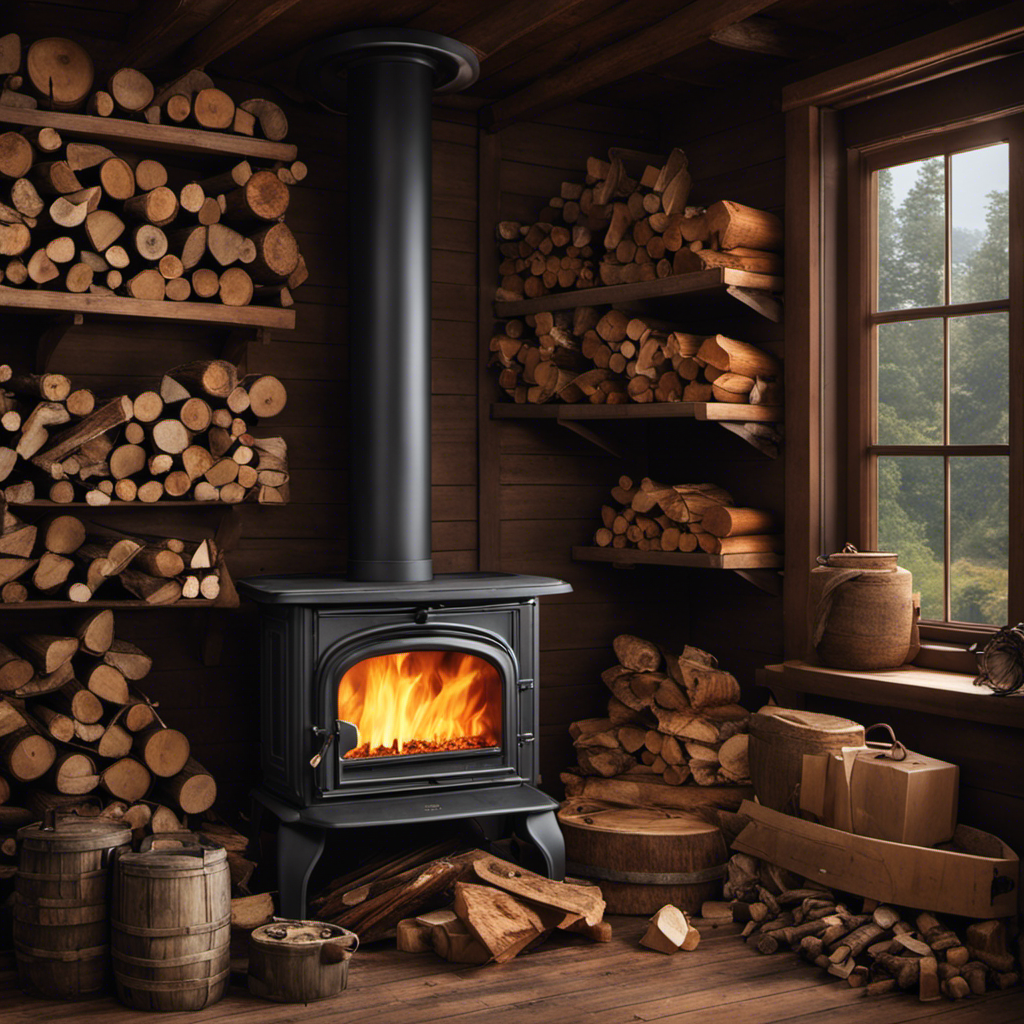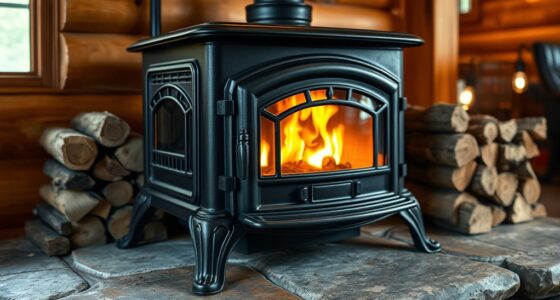As a seasoned wood stove constructor, I am excited to impart my expertise on crafting a highly efficient wood stove. By carefully choosing materials, designing an efficient combustion chamber, and incorporating a heat exchange system, you can boost the stove’s heat output while reducing its fuel consumption.
Insulating your stove and installing a secondary air system will further enhance combustion efficiency. In this article, I’ll guide you through each step, providing detailed instructions for building and maintaining a wood stove that will keep you warm and save you money.
Key Takeaways
- Select high-quality, heat-resistant materials for building the wood stove
- Properly season hardwoods like oak and maple for optimal combustion and heat production
- Design the combustion chamber with the right size and insulation materials for efficient combustion and heat transfer
- Implement effective airflow control mechanisms to maximize combustion efficiency and minimize smoke emissions
Selecting the Right Materials for Your Wood Stove
I’ve found that using high-quality, heat-resistant materials is crucial when selecting the right materials for my wood stove. Insulation techniques play a significant role in ensuring the efficiency of the stove. One of the most important factors to consider is the type of insulation used. I prefer using insulation materials that have a high R-value, such as ceramic fiber or refractory bricks. These materials have excellent heat retention properties, which helps to keep the stove hot for a longer period of time.
Another crucial aspect to consider when selecting materials for a wood stove is the fuel source. Different types of wood burn differently, and choosing the right fuel can greatly impact the stove’s performance. Hardwoods like oak, maple, and hickory burn more efficiently and produce more heat compared to softwoods like pine or fir. It’s important to properly season the wood before using it in the stove to ensure optimal combustion.

With the right materials and proper insulation techniques, you can design a wood stove that’s highly efficient and maximizes heat output. In the next section, I’ll discuss the importance of designing an efficient combustion chamber to further enhance the performance of the wood stove.
Designing an Efficient Combustion Chamber
When it comes to designing an efficient combustion chamber, there are a few key factors to consider.
The size of the chamber plays a crucial role in ensuring optimal combustion and heat transfer.
Additionally, implementing effective airflow control mechanisms allows for precise regulation of the combustion process.
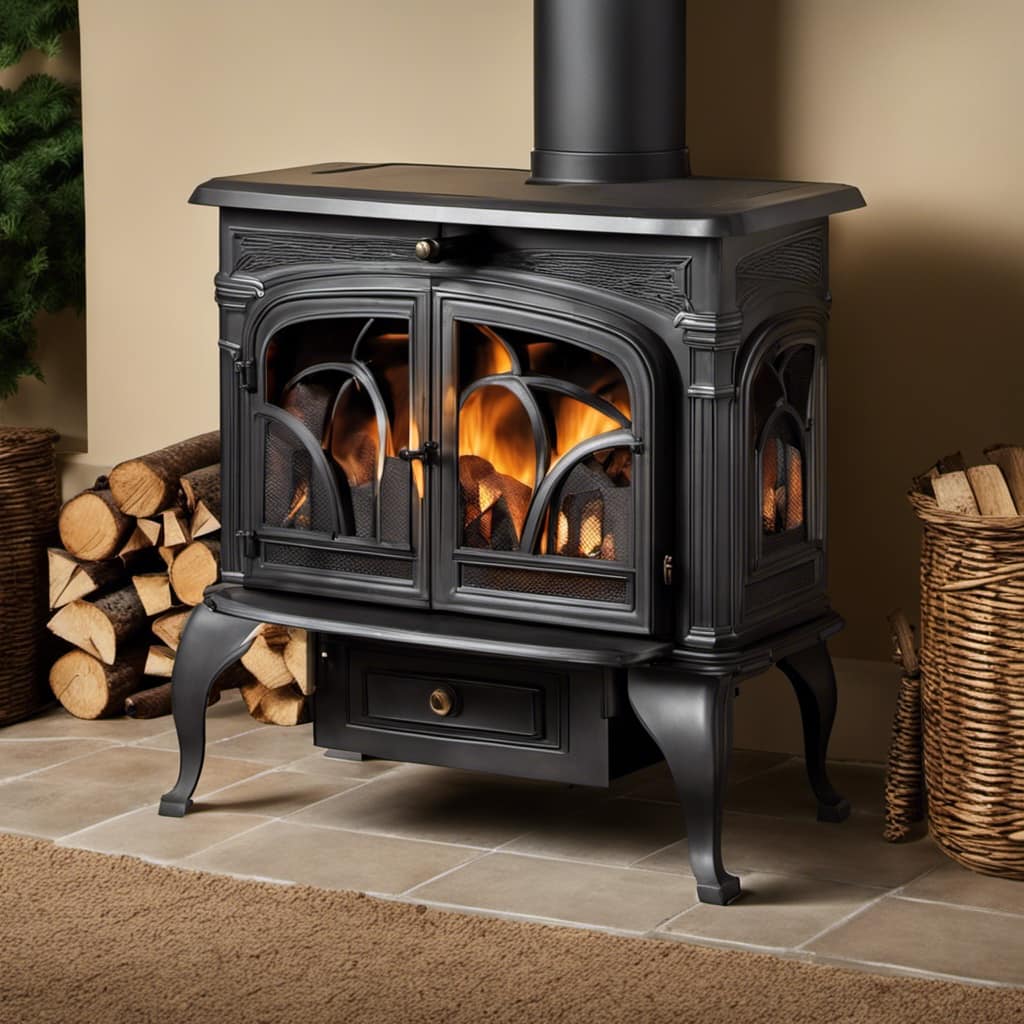
Finally, choosing the right insulation materials can significantly enhance the chamber’s efficiency by minimizing heat loss.
Combustion Chamber Size
The combustion chamber size affects the efficiency of the wood stove. When designing combustion chambers, it’s essential to consider the size and its impact on combustion efficiency. Here are three key factors to consider:
-
Optimal size: The combustion chamber should be designed to accommodate the desired fuel load while allowing for efficient combustion. A chamber that’s too small can restrict airflow and result in incomplete combustion, leading to lower efficiency.
-
Air distribution: The size of the combustion chamber influences the distribution of air within it. Proper air distribution is crucial for achieving complete combustion and maximizing efficiency.

-
Heat transfer: The size of the combustion chamber also affects the heat transfer process. A larger chamber allows for more contact between the burning fuel and the heat exchange surfaces, promoting better heat transfer and higher efficiency.
Considering these factors, designing a combustion chamber with the appropriate size is crucial for optimizing combustion efficiency in a wood stove. This efficiency can be further enhanced by incorporating effective airflow control mechanisms.
Airflow Control Mechanisms
To maximize the efficiency of my wood stove, I need to incorporate effective airflow control mechanisms. Airflow optimization is crucial for achieving complete combustion and minimizing smoke emissions. By controlling the amount of air entering the combustion chamber, I can regulate the intensity of the fire and ensure efficient fuel consumption. To help you understand the importance of airflow control, here is a table showcasing the different control mechanisms and their impact on the stove’s performance:
| Control Mechanism | Description | Benefits |
|---|---|---|
| Primary Air Intake | Controls the amount of air entering the combustion chamber | Enhances combustion efficiency and reduces smoke |
| Secondary Air Intake | Provides additional oxygen for complete combustion of gases and particulate matter | Increases heat output and reduces emissions |
| Damper | Adjusts the flue gas flow by restricting or allowing more air | Allows for better heat retention and improved burn rate |
Now that we have covered airflow optimization and controlling smoke, let’s move on to the next important aspect of building an efficient wood stove: insulation materials for efficiency.

Insulation Materials for Efficiency?
Using high-quality insulation materials is essential for maximizing the efficiency of my heating device. Insulation plays a crucial role in preventing heat loss and ensuring that the heat generated by the wood stove is effectively utilized. There are different types of insulation materials available, each with its own unique benefits.
Fiberglass insulation: Made from fine glass fibers, it’s lightweight and easy to install. It offers excellent thermal resistance and helps to minimize heat transfer.
Ceramic insulation: Known for its high-temperature resistance, it’s ideal for wood stoves. It retains heat efficiently and provides excellent insulation.
Vermiculite insulation: This natural mineral material is lightweight and highly porous. It’s effective at trapping heat and reducing energy consumption.
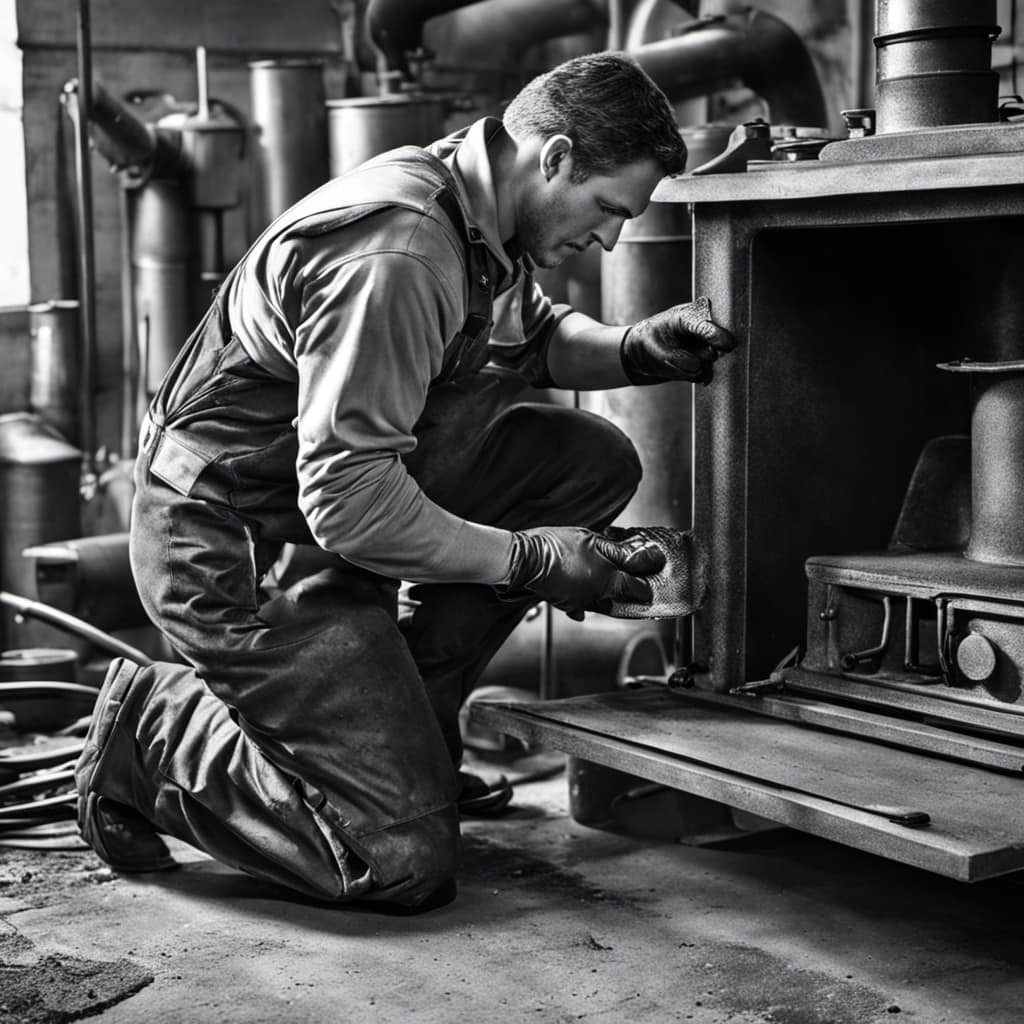
Investing in high-quality insulation materials not only improves the efficiency of my heating device but also reduces energy costs and enhances overall comfort in my space.
Building a Heat Exchange System for Maximum Efficiency
I can increase the efficiency of my wood stove by building a heat exchange system. Heat exchange designs are a great way to improve wood stove efficiency by capturing and utilizing the heat that would otherwise be wasted.
One popular design is the water jacket heat exchanger. This system consists of a series of pipes or tubes that are placed around the stove, allowing water to circulate and absorb the heat. The heated water can then be used for various purposes, such as heating the home or providing hot water.
Another option is the air-to-air heat exchanger, which uses a fan to blow air over the hot stove and distribute the warmed air throughout the room. This method is particularly effective in larger spaces.
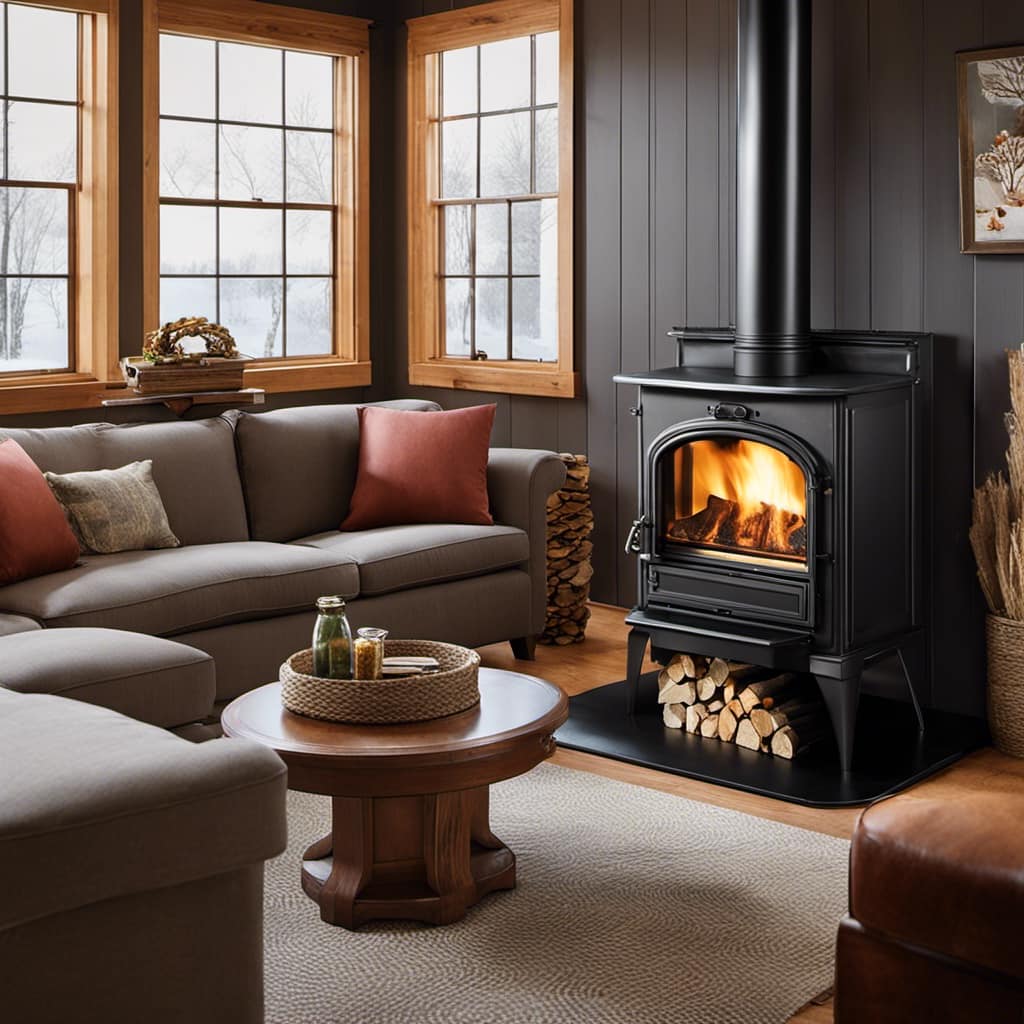
Insulating Your Wood Stove for Optimal Heat Retention
I’ve learned from my years of experience that insulating your wood stove is key to maximizing heat retention.
By properly insulating your stove, you can prevent heat loss and ensure that the warmth stays inside your home where it belongs.
There are various insulation materials available, such as fire bricks and ceramic fiber blankets, that can help you achieve optimal heat retention and ultimately save on energy costs.
Heat Retention Techniques
To maximize heat retention, insulating the walls of the wood stove with fire bricks is essential. Fire bricks are dense and can withstand high temperatures, making them perfect for this purpose.

Here are some additional techniques to enhance heat retention and optimize airflow in your wood stove:
-
Seal any gaps or cracks in the stove using high-temperature silicone or stove cement. This will prevent heat from escaping and ensure efficient burning.
-
Install a baffle or heat exchanger inside the stove. This will help to extract more heat from the flue gases and transfer it to the room.
-
Use a secondary combustion system, such as a catalytic converter or a secondary air supply, to burn the gases and particles that would otherwise be wasted. This will increase the efficiency of your stove and reduce emissions.

Insulation Material Options
Using fire bricks as insulation material is crucial for maximizing heat retention in my home heating system. When it comes to heat resistant materials, fire bricks are an excellent option due to their ability to withstand high temperatures without cracking or crumbling.
These bricks are made from a combination of clay and other heat-resistant minerals, making them ideal for insulating the walls of my wood stove. Not only do fire bricks effectively trap the heat inside the stove, but they also prevent the heat from escaping into the surrounding environment. This ensures that the heat is efficiently utilized and reduces the need for constant refueling.
Moreover, fire bricks are cost-effective options as they’re durable and long-lasting, providing excellent value for money. With fire bricks as my insulation material, I can enjoy a more efficient and effective heating system in my home.
Transitioning to the next section, let’s explore the energy-saving benefits of proper insulation and heat retention.
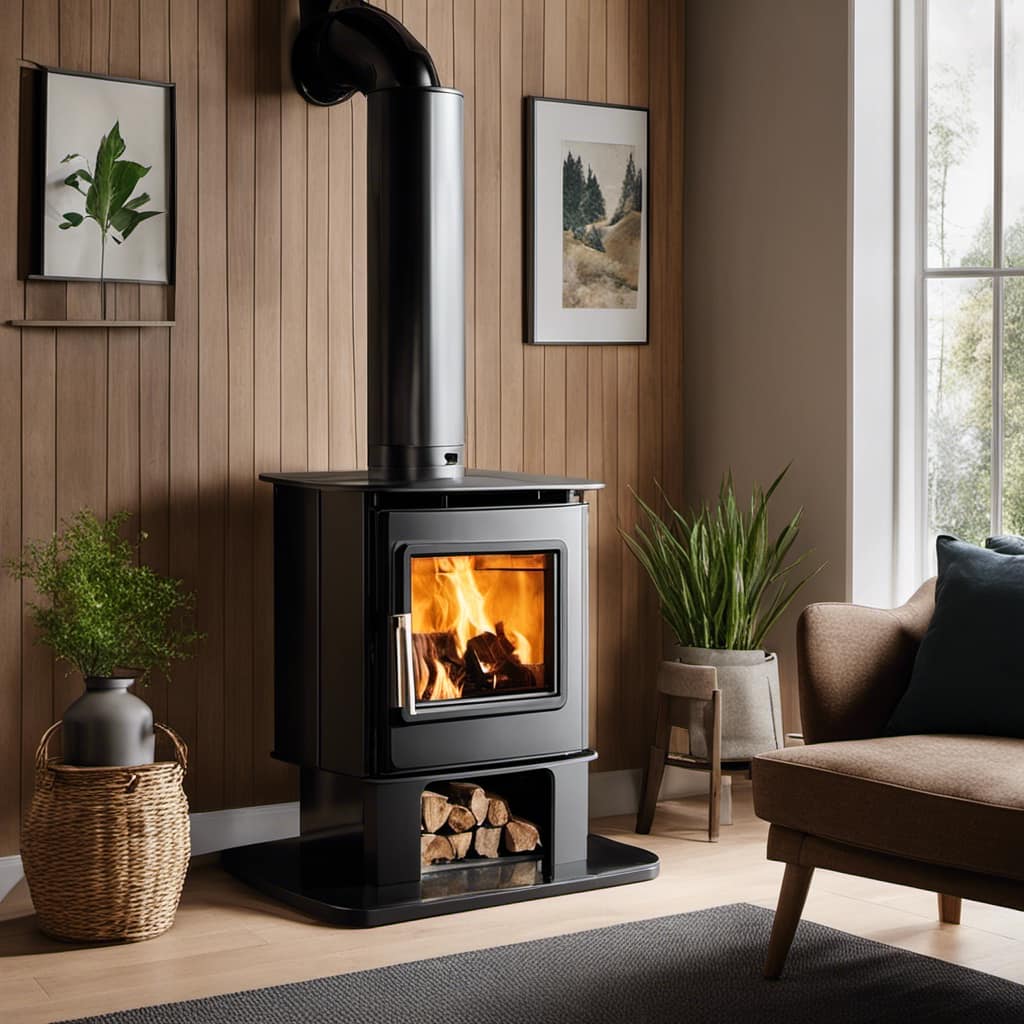
Energy-Saving Benefits
As an energy-conscious homeowner, I can attest to the significant savings achieved through proper insulation and heat retention. By implementing energy-saving techniques, not only can we reduce our carbon footprint, but we can also enjoy lower energy bills and a more comfortable living space.
Here are some key benefits of energy-saving techniques:
-
Reduced energy consumption: Proper insulation and heat retention techniques help to minimize the amount of energy needed to heat our homes, resulting in lower energy bills and a reduced impact on the environment.
-
Enhanced comfort: Effective insulation keeps our homes warmer in the winter and cooler in the summer, creating a more comfortable living environment all year round.
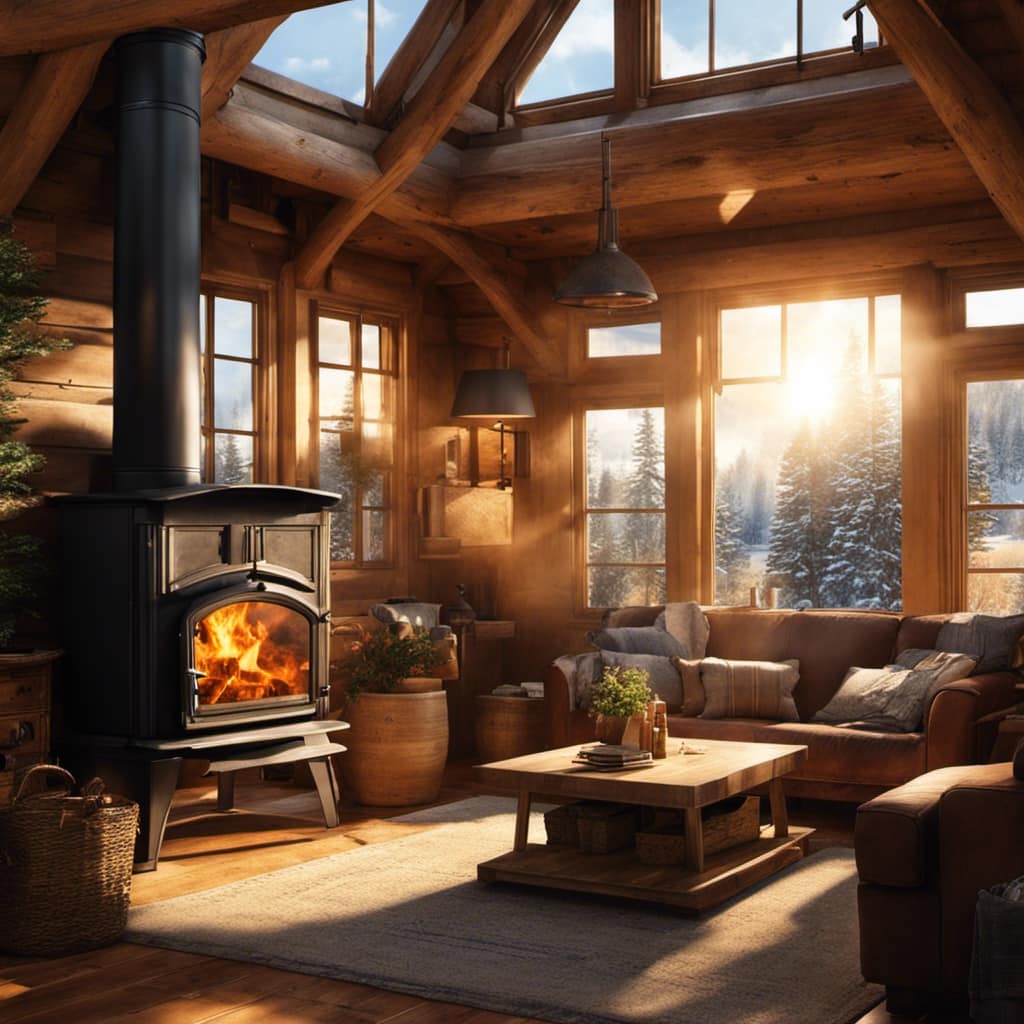
-
Increased sustainability: By reducing our energy consumption, we contribute to the overall sustainability of our planet, ensuring a greener future for generations to come.
Considering these energy-saving benefits, it’s essential to explore additional techniques such as installing a secondary air system for complete combustion.
Installing a Secondary Air System for Complete Combustion
I can install a secondary air system to ensure complete combustion in my wood stove. This modification is highly effective in improving draft and reducing smoke emissions. By introducing a second source of air into the stove, I can enhance the combustion process and achieve a more efficient burn.
To install a secondary air system, I need to first identify the ideal location for the air intake. Typically, it’s placed near the top of the firebox, where it can provide oxygen directly to the flames. Once I determine the location, I can drill a small hole and attach a pipe or duct to connect it to the outside air source.
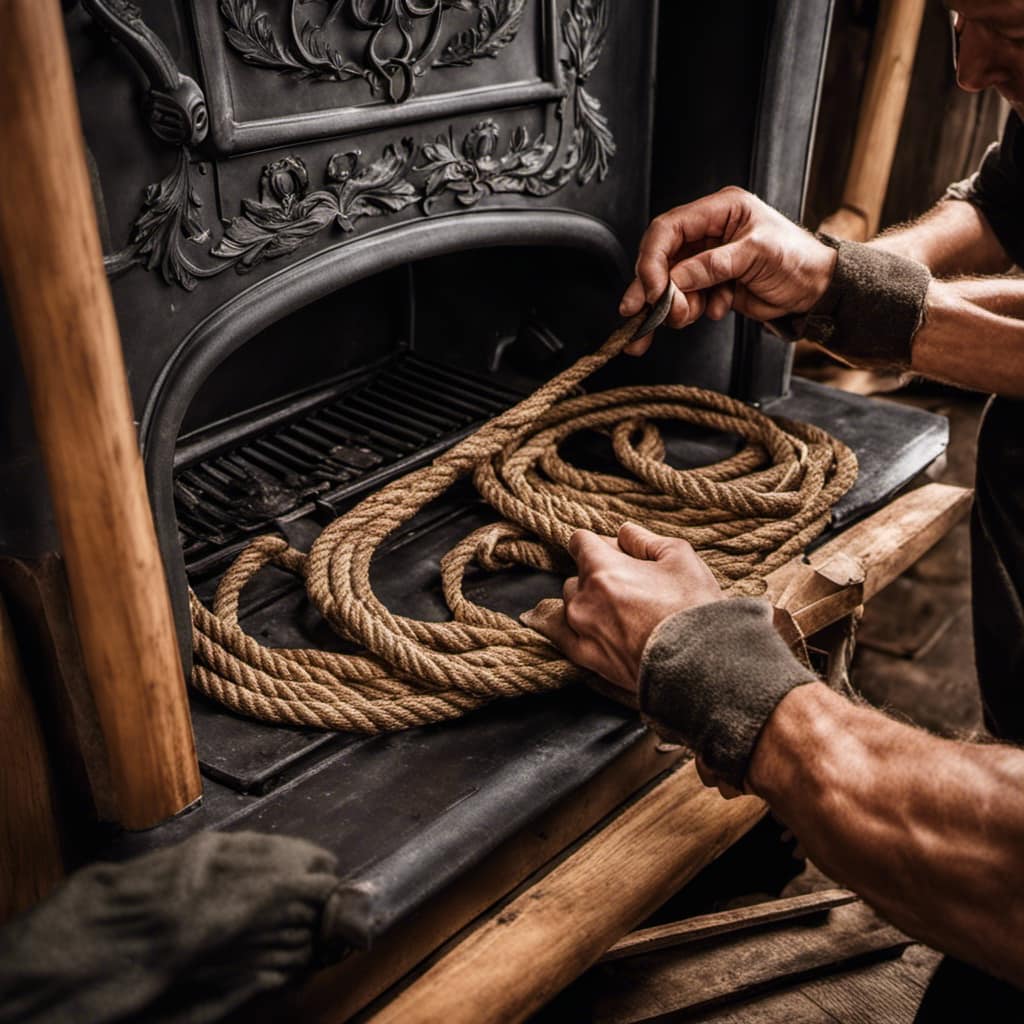
Next, I need to adjust the airflow to achieve optimal combustion. This can be done by installing a damper or a control mechanism that allows me to regulate the amount of secondary air entering the stove. By finding the right balance, I can ensure complete combustion without wasting excessive heat or creating unnecessary smoke.
Installing a secondary air system is a relatively simple and cost-effective way to maximize the efficiency of my wood stove. Not only will it improve the overall performance, but it will also reduce harmful emissions and promote cleaner air in my home.
Maintaining and Cleaning Your Efficient Wood Stove
To keep my wood stove running efficiently, I regularly clean and maintain it to ensure optimal performance. Cleaning techniques are essential in preventing creosote buildup, which can lead to chimney fires and reduced efficiency.
Here are some effective methods I use to maintain my wood stove:
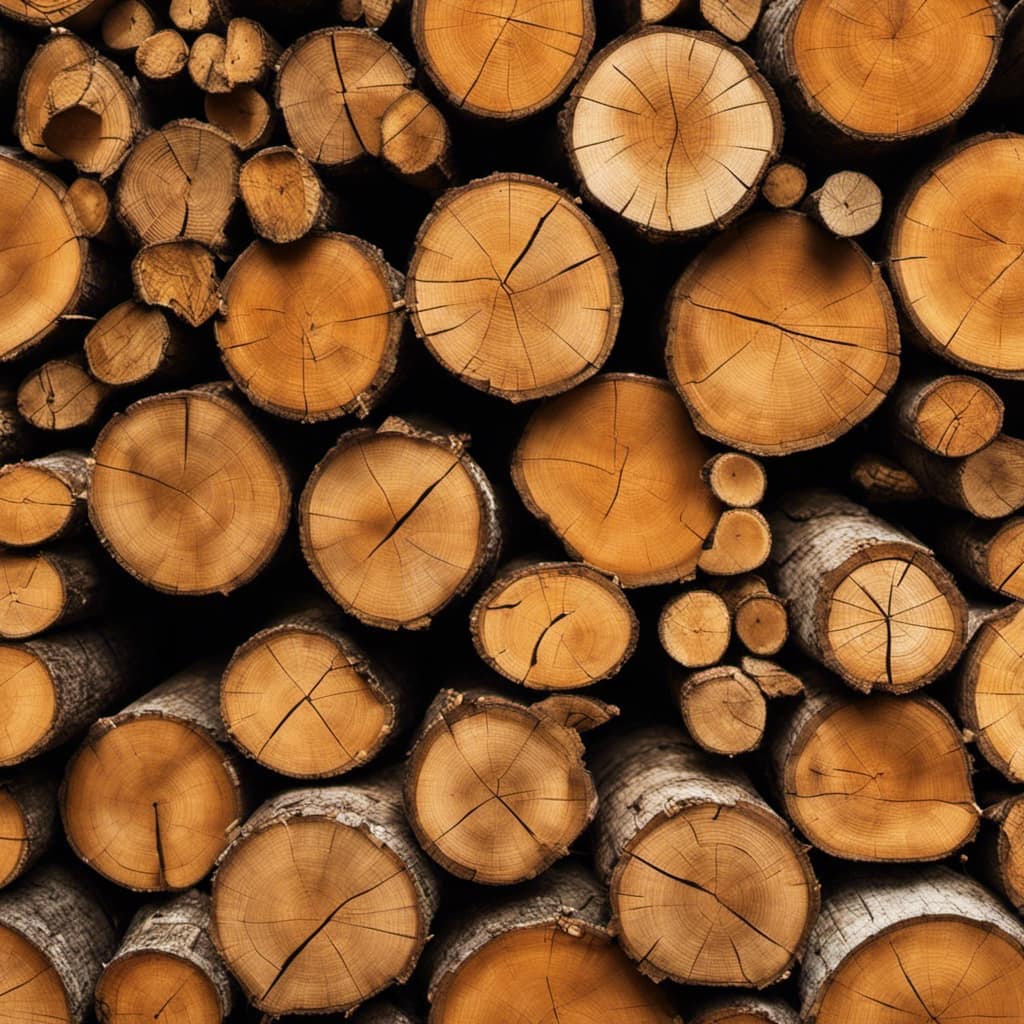
-
Regular Ash Removal: I make sure to remove the ash from the firebox after each use. This prevents the build-up of ash, which can restrict airflow and hinder combustion efficiency.
-
Chimney Sweeping: I schedule annual chimney cleanings to remove any creosote deposits that may have accumulated over time. A professional chimney sweep will thoroughly clean the chimney, reducing the risk of chimney fires.
-
Glass Cleaning: The glass on the wood stove’s door can become sooty and reduce visibility. I clean it regularly using a glass cleaner specifically designed for wood stoves. This not only improves the aesthetic appeal but also allows me to monitor the flames and adjust the airflow accordingly.
By following these cleaning techniques, I ensure that my wood stove remains in optimal condition, providing efficient heat and reducing the risk of creosote buildup.
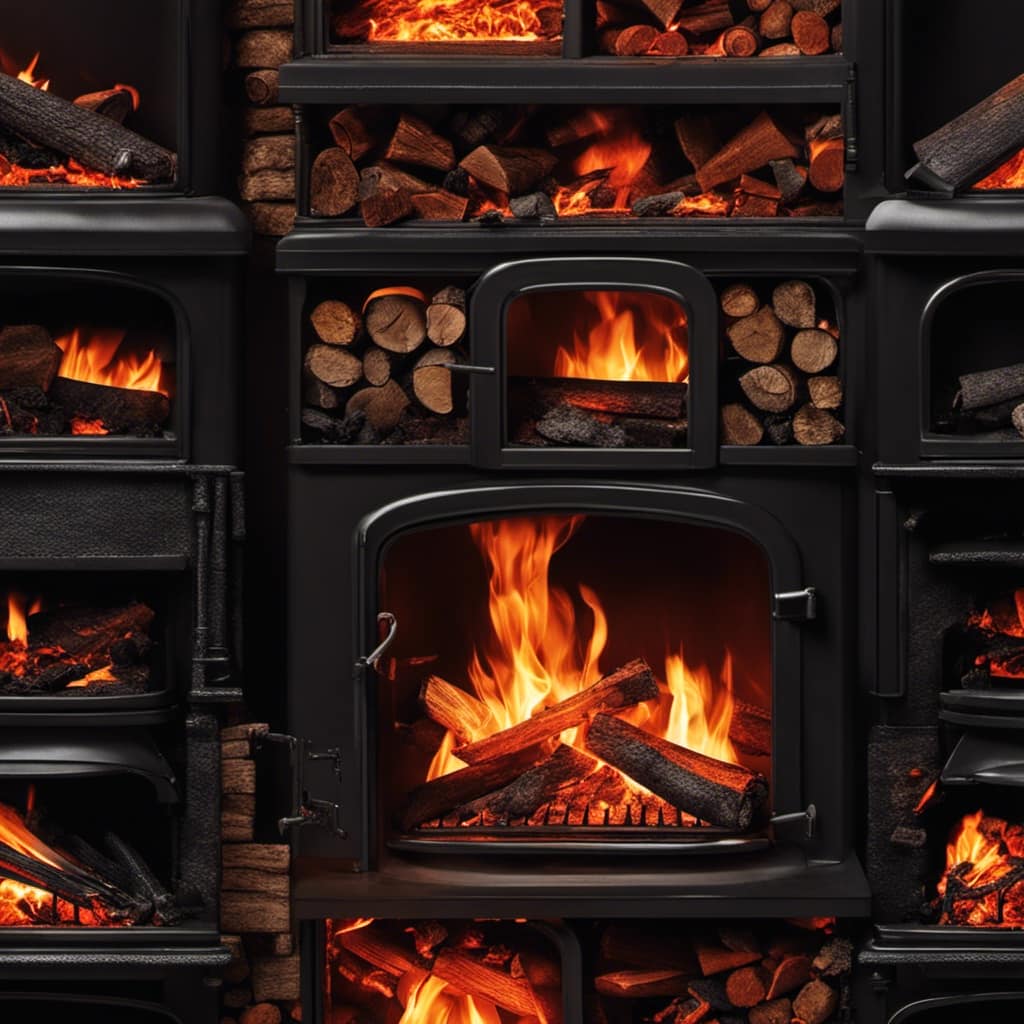
Regular maintenance and cleaning are crucial for the longevity and performance of any wood stove.
Frequently Asked Questions
How Much Does It Cost to Build an Efficient Wood Stove?
Building an efficient wood stove can vary in cost depending on factors such as materials, design, and labor.
To ensure cost-effectiveness, it’s essential to consider the stove’s energy efficiency. Efficient wood stoves are designed to maximize heat output while minimizing fuel consumption. This can result in significant cost savings over time.
What Are the Potential Health Hazards Associated With Using a Wood Stove?
Potential health hazards associated with using a wood stove include:
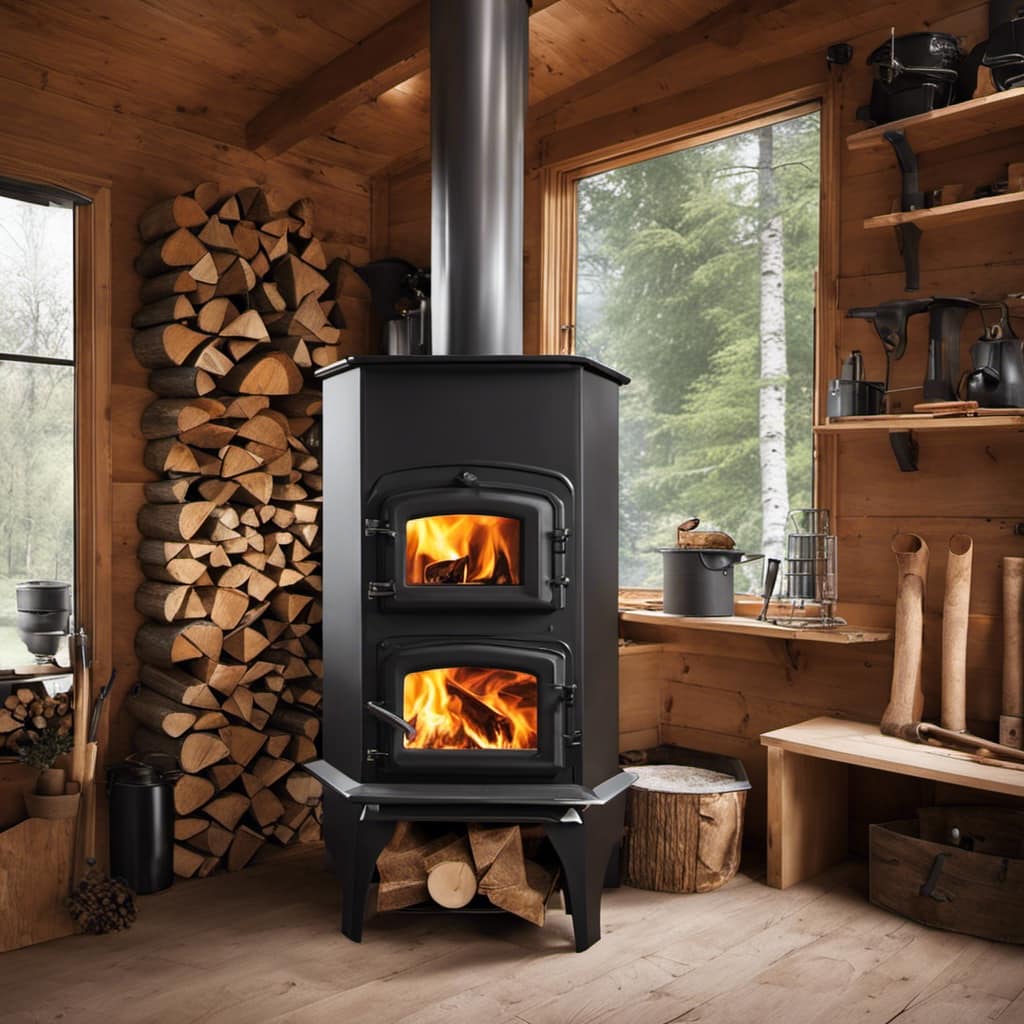
- Carbon monoxide poisoning
- Respiratory issues
- Increased risk of asthma attacks
To minimize these risks, it’s important to:
- Ensure proper ventilation
- Regularly clean and maintain the stove
- Use dry and seasoned wood
Other precautions to take include:
- Installing carbon monoxide detectors
- Practicing good fire safety measures
Being aware of these potential hazards and taking necessary precautions can help ensure a safe and healthy environment when using a wood stove.
Can I Use Any Type of Wood in My Wood Stove?
Yes, you can use different types of wood in your wood stove, but some are more suitable than others.
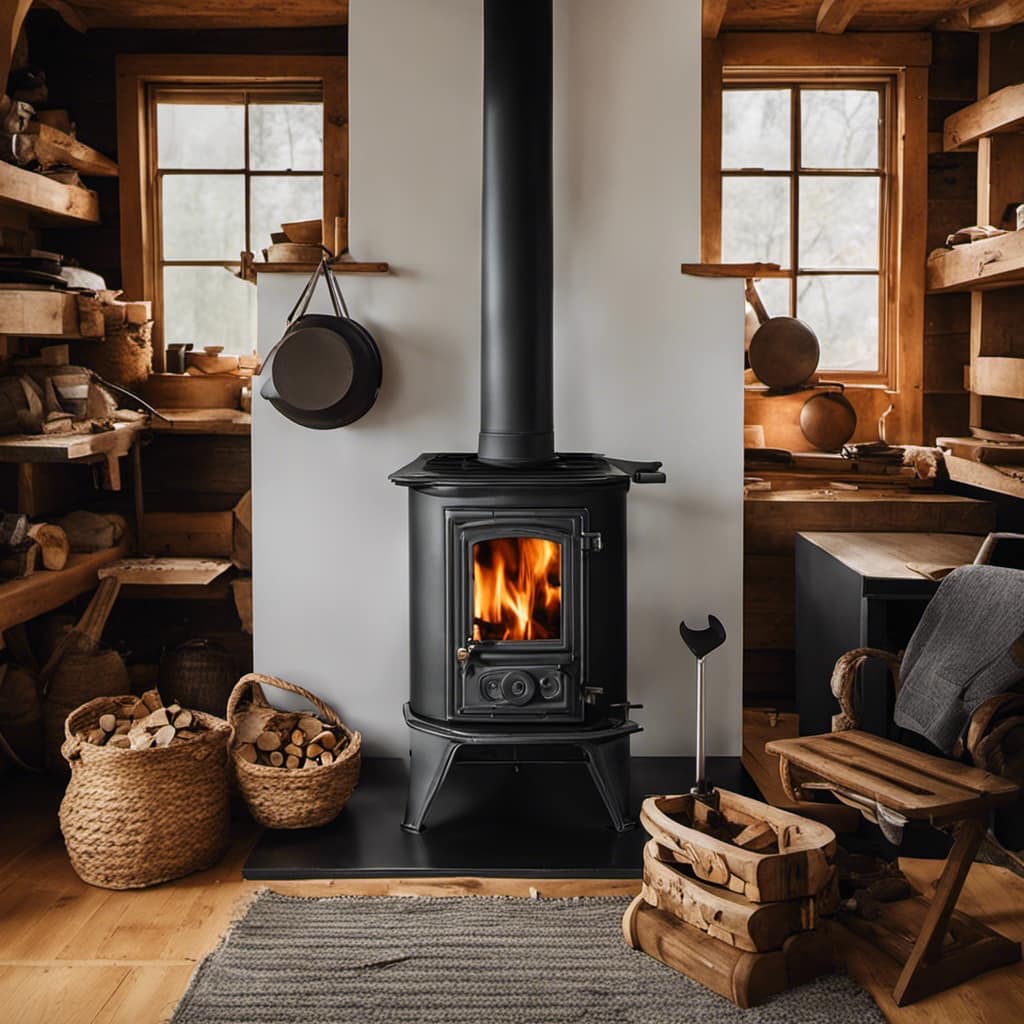
Hardwoods like oak, maple, and birch are ideal because they burn longer and produce more heat.
Softwoods like pine and fir can be used, but they burn faster and produce less heat.
It’s important to properly store and season your wood to ensure it burns efficiently.
This involves keeping it dry, allowing it to air out, and removing any moisture.
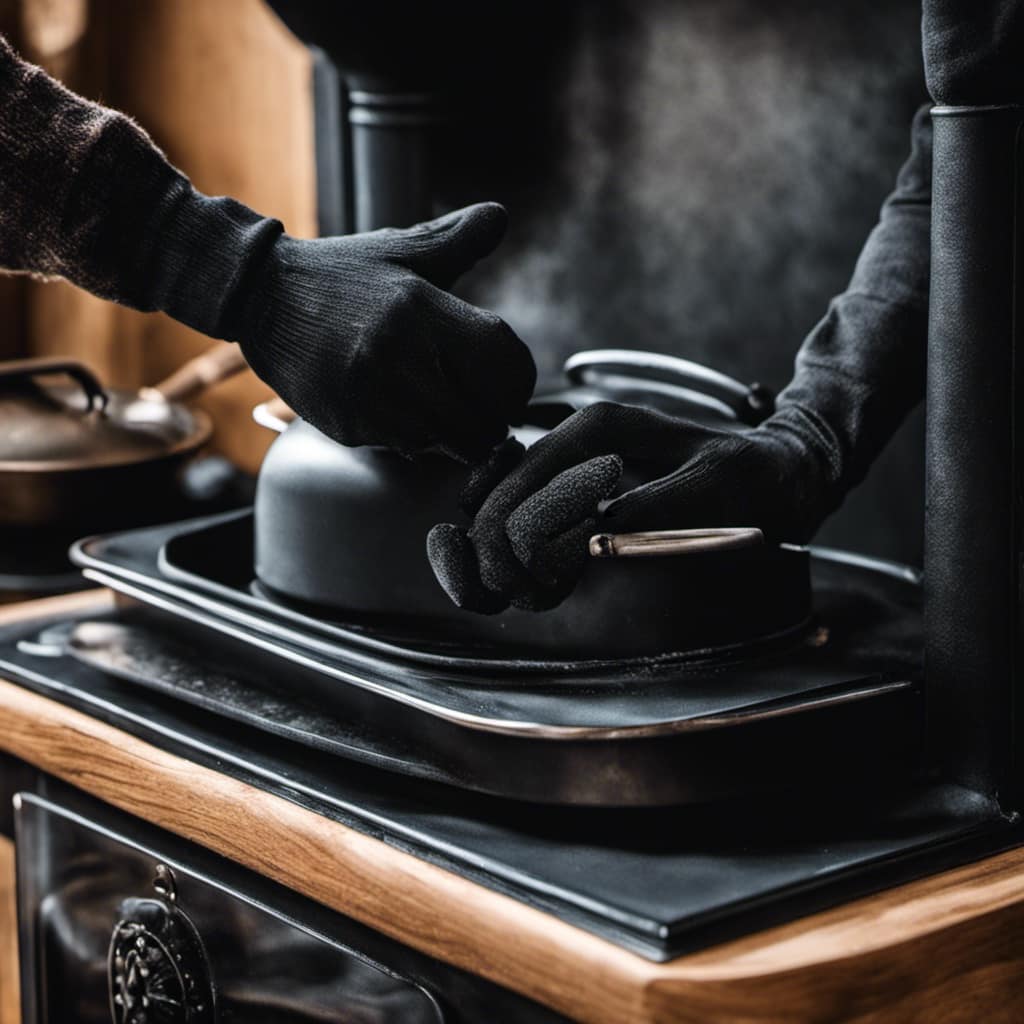
How Often Do I Need to Clean My Wood Stove to Maintain Its Efficiency?
Cleaning frequency is key to maintaining the efficiency of your wood stove. Regular cleaning ensures optimal performance and reduces the risk of fire hazards.
As an experienced stove owner, I recommend cleaning your wood stove at least once a month during the burning season. This includes removing ashes, checking for creosote buildup, and inspecting the chimney.
Following these maintenance tips will keep your wood stove running smoothly and efficiently for years to come.
Are There Any Regulations or Permits Required for Installing a Wood Stove in My Home?
When it comes to installing a wood stove in your home, it’s important to be aware of the regulations and permits that may be required. These vary depending on your location, so it’s best to check with your local authorities or building department.

They can provide you with specific guidelines and requirements that need to be followed to ensure a safe and legal installation.
Taking the time to research and comply with these regulations will help you enjoy your wood stove with peace of mind.
Conclusion
In conclusion, building an efficient wood stove requires careful selection of materials and a well-designed heat exchange system.
Additionally, thoughtful design of the combustion chamber, proper insulation, and an effective secondary air system are essential.
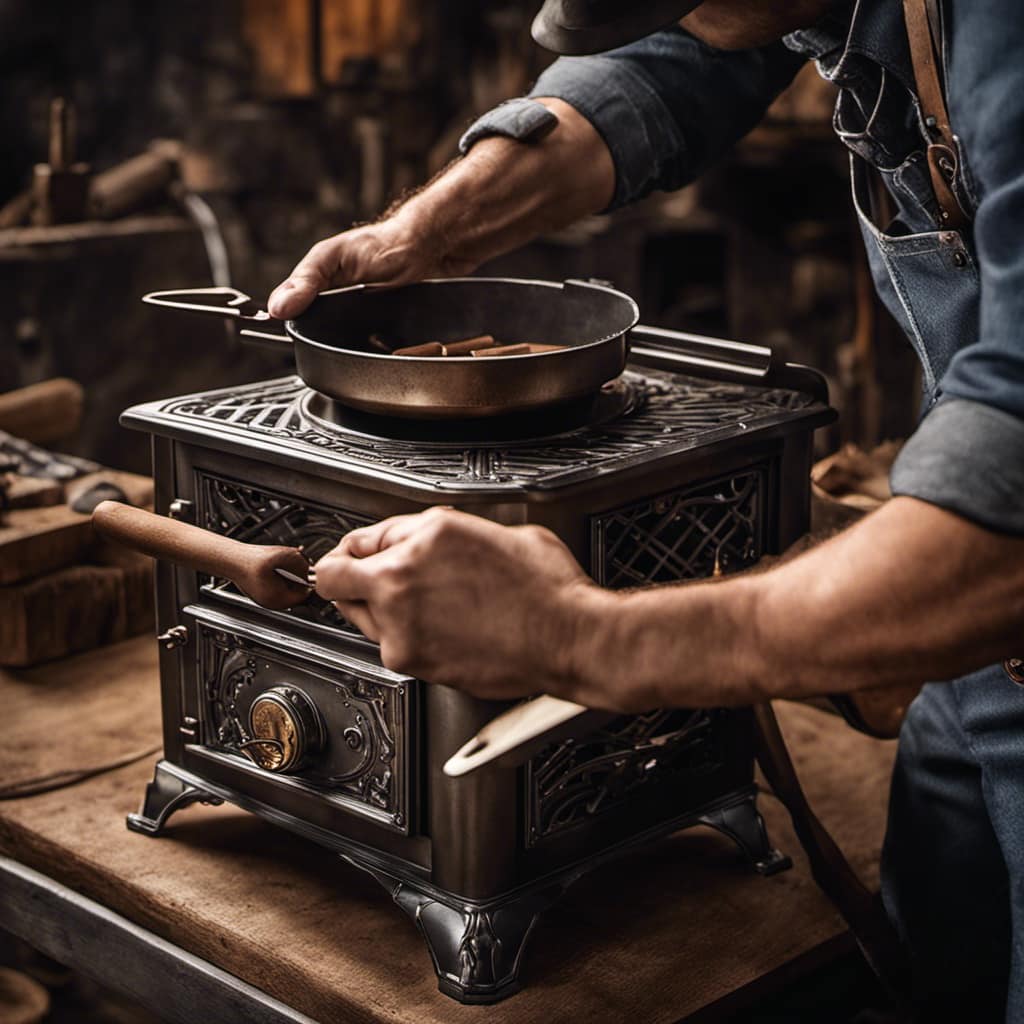
By incorporating these elements, you can maximize heat retention and achieve complete combustion.
Remember, ‘a stitch in time saves nine’ when it comes to maintaining and cleaning your wood stove, ensuring its longevity and continued efficiency.
With the right knowledge and attention to detail, you can enjoy the warmth and benefits of an efficient wood stove for years to come.



